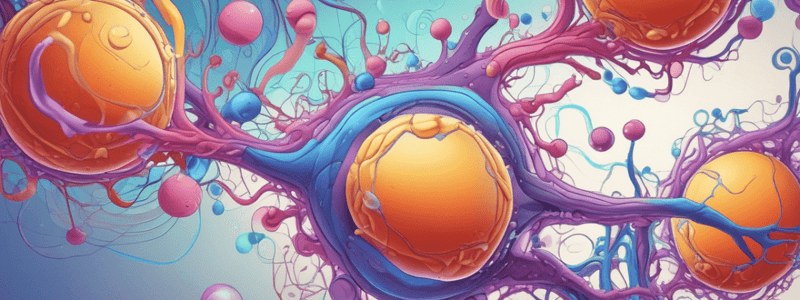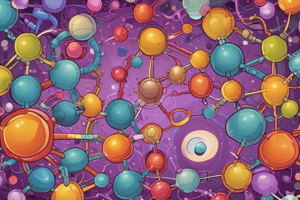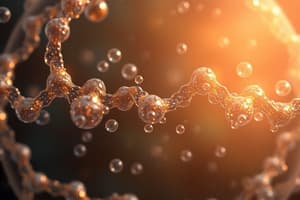Podcast
Questions and Answers
What is the common and defining feature of lipids?
What is the common and defining feature of lipids?
- Solubility in non-polar solvents
- Solubility in water
- Being a source of energy
- Insolubility in water (correct)
What is the functional group of fatty acids?
What is the functional group of fatty acids?
- Amine
- Hydroxyl
- Aldehyde
- Carboxyl (correct)
How are the carbon atoms in fatty acids numbered?
How are the carbon atoms in fatty acids numbered?
- Starting from the methyl terminus
- Alternating
- Starting from the carboxyl terminus (correct)
- Randomly
What is the name of the C18 saturated fatty acid?
What is the name of the C18 saturated fatty acid?
What is the role of lipids in the cell?
What is the role of lipids in the cell?
What is the solvent in which lipids are highly soluble?
What is the solvent in which lipids are highly soluble?
What is the name of the lipid found in the brain?
What is the name of the lipid found in the brain?
What is the characteristic of glycolipids that differs from sphingomyelin?
What is the characteristic of glycolipids that differs from sphingomyelin?
What is the simplest type of glycolipid?
What is the simplest type of glycolipid?
What is the orientation of the cholesterol molecule in membranes?
What is the orientation of the cholesterol molecule in membranes?
What is the origin of bile salts?
What is the origin of bile salts?
What is the characteristic of saturated fatty acids?
What is the characteristic of saturated fatty acids?
What is the desired level of High Density Lipoprotein Cholesterol (HDL-C)?
What is the desired level of High Density Lipoprotein Cholesterol (HDL-C)?
What type of fatty acid has its hydrogen atoms on opposite sides of the double bond?
What type of fatty acid has its hydrogen atoms on opposite sides of the double bond?
What is the name of the fatty acid that is derived from the diet and is necessary for vital functions?
What is the name of the fatty acid that is derived from the diet and is necessary for vital functions?
What is the main component of very low density lipoprotein (VLDL) and chylomicrons?
What is the main component of very low density lipoprotein (VLDL) and chylomicrons?
What is the name of the molecule that a triglyceride is formed from, along with three fatty acids?
What is the name of the molecule that a triglyceride is formed from, along with three fatty acids?
What is the name of the alcohol that phospholipids may be attached to, in addition to glycerol?
What is the name of the alcohol that phospholipids may be attached to, in addition to glycerol?
Study Notes
Fatty Acids
- Saturated fatty acids have no double bonds and carry the maximum possible number of hydrogen atoms, example: Stearic Acid.
- Unsaturated fatty acids lack hydrogen atoms and have at least one double bond, example: Linoleic Acid.
- Cis fatty acids have hydrogen atoms on the same side of the double bond.
- Trans fatty acids have hydrogen atoms on opposite sides of the double bond.
- Essential fatty acids are derived from the diet and are necessary for vital functions, examples: Linoleic (C18:2 ω6) and α-Linolenic (C18:3 ω3).
- Non-essential fatty acids are produced by the body.
Triglycerides
- A triglyceride is formed from a molecule of glycerol and three fatty acids.
- Triglycerides are major components of very low density lipoprotein (VLDL) and chylomicrons.
- Triglycerides are important in metabolism as energy sources and transporters of dietary fat.
Phospholipids
- Phospholipids contain one or more fatty acids attached to a phosphate and an alcohol.
- Phospholipids can be attached to glycerol or sphingosine.
- Phospholipids derived from glycerol are called phosphoglycerides, example: Cardiolipin.
- Phospholipids derived from sphingosine are called Sphingomyelin, found in the brain.
Glycolipids
- Glycolipids are sugar-containing lipids derived from sphingosine.
- The simplest glycolipid is a cerebroside, containing a sugar residue of glucose or galactose, found in neural tissue.
Sterol Lipids
- Cholesterol is built from 4 linked hydrocarbon rings with a hydrocarbon tail and a hydroxyl group.
- In membranes, cholesterol's hydroxyl group interacts with nearby phospholipid head groups.
- Bile salt originates from cholesterol and has the 4 linked hydrocarbon rings plus taurine or glycine or both.
Lipid Profile
- High density lipoprotein cholesterol (HDL-C) is >1.2 mmol/L.
- Low density lipoprotein cholesterol (LDL-C) is 2.4 mmol/L.
- Triglyceride (TG) levels are important in lipid profiles.
Lipids Definition and Functions
- Lipids are a chemically diverse group of organic compounds defined by their insolubility in water.
- Lipids are highly soluble in non-polar solvents like chloroform and ether.
- Lipids' water-insolubility contributes to the complexity in their digestion, transport, and metabolism.
- Lipids are essential to the overall energy economy of the cell.
Studying That Suits You
Use AI to generate personalized quizzes and flashcards to suit your learning preferences.
Related Documents
Description
Test your knowledge on the structures, types, and functions of lipids, including their role in gaseous exchange and diseases associated with lipid storage. This quiz covers the basics of lipids and their importance in biology.




